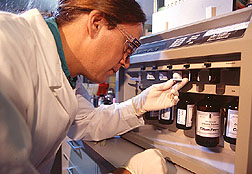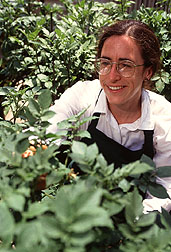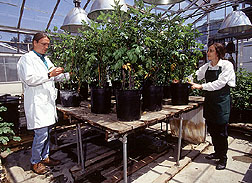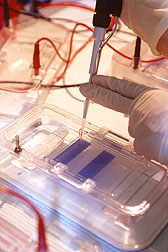Ubi7—New Tool for Potato Breeders
|
|
Tomorrow's potatoes might easily fend off rot-causing microbes, thanks in part to a friendly gene known as ubiquitin7. ARS researchers snipped part of the gene, hooked it onto a soft-rot-fighting gene, and inserted this new combination into experimental potatoes.
In preliminary laboratory and greenhouse tests, the tubers resisted attack by the microorganism that causes soft rot, according to William R. Belknap of the Agricultural Research Service's Western Regional Research Center in Albany, California.
The piece of the ubiquitin7, or ubi7, gene that scientists prize is called a promoter. Its job: to turn a gene on. To a genetic engineer, a strong promoter is an invaluable tool.
For more than three decades, scientists have known that promoters borrowed from one gene can be fitted onto another to boost the second gene's effectiveness. Ideally, the borrowed promoter also dictates when and where within the plant the gene should turn on.
Ubi7 captured the attention of Belknap's team because wounding turned on that gene in tubers analyzed in their laboratory.
|
|
"When wounding occurs," says Joan E. Garbarino, "rot may follow. We reasoned that hooking rot-fighting genes to the ubi7 promoter would make the anti-rot gene more effective when tubers were damaged—the time they need protection the most."
That is what happened in Garbarino's laboratory tests with quarter-inch-thick slices of greenhouse-grown potatoes. The tubers had the ubi7 promoter, hitched to the anti-rot genes, working inside.
To simulate the injury that might occur as potatoes make their way from field to table, Garbarino stabbed the slices with a toothpick, then exposed them to the rot-causing organism, Erwinia carotovora. After 5 days, tubers with the ubi7-driven anti-rot genes had 85 to 96 percent less decay than those without this gene-promoter combination. Slices from conventional potatoes turned watery with decay.
Garbarino works in Belknap's laboratory under a cooperative research and development agreement initiated in 1994 between Demeter BioTechnologies, Ltd., of Durham, North Carolina, and ARS. The company developed the rot-resistance genes used in the experiments. ARS and Demeter are seeking a patent for the ubi7 promoter.
Not Just a Problem in Potatoes
The E. carotovora bacterium that causes soft rot gets its name from carrots, the crop in which it was first isolated and named. A soil-dwelling microbe, it invades potatoes and other crops either in the field or in storage. The rot causes afflicted tissue to become soft and watery and then turn slimy and foul-smelling.
|
|
E. carotovora also ruins other vegetables and fruits including cucumbers, onions, tomatoes, lettuce, and some ornamental plants like iris.
"We refer to Erwinia carotovora as the 'flesh-eating bacteria' of the plant world,'" says Richard D. Ekstrom, Demeter's president. Though ARS tests have been limited to potatoes, the scientists anticipate that these other crops might also benefit from new protection offered by Erwinia-resistance genes linked to the ubi7 gene's adept promoter.
Potatoes need antimicrobial protection because damage from machinery and routine jostling and tumbling during harvest and handling "is unavoidable, despite the concerted effort by growers and shippers to handle tubers gently," says Belknap.
In their laboratory experiments, Belknap and Garbarino worked with David R. Rockhold of the Albany center and former Albany colleagues Timothy M. Rickey and Teruko Oosumi.
Belknap provided dozens of the genetically engineered tubers to ARS scientists at Aberdeen, Idaho, for the 1997 growing season. They're completing the first-ever outdoor tests of the anti-rot genes hitched to the ubi7 promoter.
ARS plant pathologist Dennis L. Corsini and geneticist Joseph J. Pavek lead those experiments. They're scrutinizing the high-tech tubers not only for soft rot resistance, but also for size and other traits important to growers and consumers.
Previously at Albany, the team had discovered another ubiquitin gene, which they named ubi3. In early tests, it seemed the ubi3 promoter should turn on genes in wound tissue when injury occurred. "But we couldn't get that to happen," Garbarino says. "We saw ubi3 go to work in wounded and nonwounded tissue alike, even in leaves, for example."
|
|
However, an increasing need—worldwide—for new promoters has meant that plant genetic engineering researchers have been anxious to try out ubi3. So far, Belknap has shipped the promoter to more than three dozen labs in the United States and abroad.
"We make ubi3 available free of charge to any molecular biology lab that needs it," says Belknap. "It seems to be a good all-purpose promoter for switching a gene on and leaving it on."
To home in on the ubi3 and ubi7 genes, Belknap used a ubiquitin-seeking molecular probe from Peter H. Quail of the University of California at Berkeley and ARS Plant Gene Expression Center at Albany. The probe derives from the ubiquitin1 gene that was discovered by Quail, former Albany colleague Alan H. Christensen, and others.
Potatoes are America's most popular vegetable. U.S. potato growers produced about 25 million tons of the tubers in l996, worth about $2 billion. Though some are raised for fresh-market sale, most are processed into fries, chips, dehydrated flakes, or other top-selling products.
— By Marcia Wood, Research Service Information Staff, 800 Buchanan St., Albany, CA 94710; phone (510) 559-6070.
William R. Belknap is in the USDA-ARS Crop Improvement and Utilization Research Unit, Western Regional Research Center, 800 Buchanan St., Albany, CA 94710; phone (510) 559-6072, fax (510) 559-5775. Dennis L. Corsini and Joseph J. Pavek are in the USDA-ARS Small Grains and Potato Germplasm Research Unit, 1691 South 2700 West, Aberdeen, ID 83210; phone (208) 397-4162, fax (208) 397-4165.
Peter H. Quail is with the USDA-ARS and University of California at Berkeley Plant Gene Expression Center, 800 Buchanan St., Albany, CA 94710; phone (510) 559-5900, fax (510) 559-5678.
"Ubi7—New Tool for Potato Breeders" was published in the January 1998 issue of Agricultural Research magazine. Click here to see this issue's table of contents.










